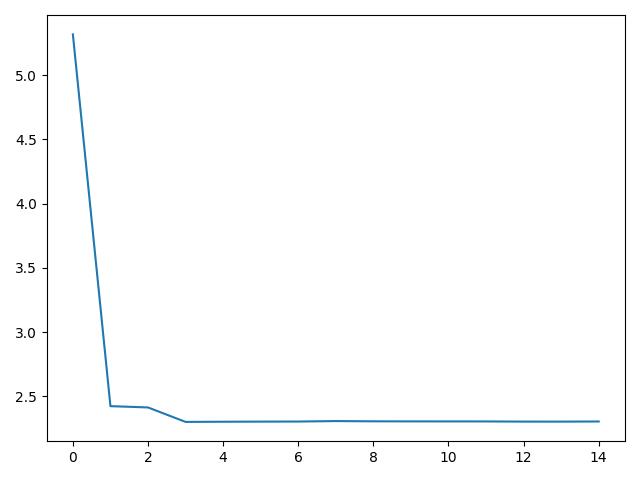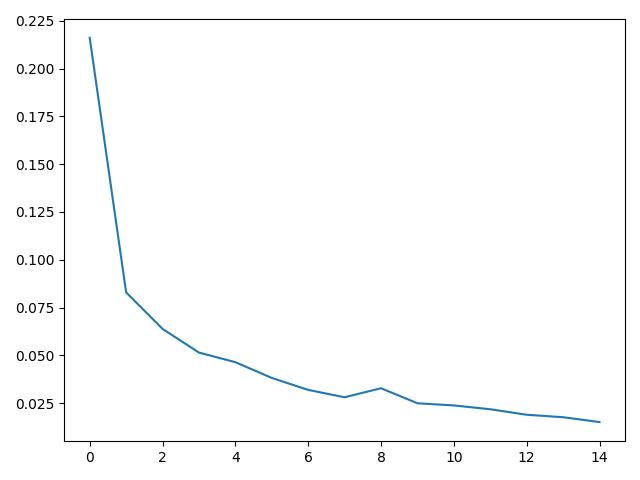深度学习------用NNCNNRNN神经网络实现mnist数据集处理
Posted 小飞龙程序员
tags:
篇首语:本文由小常识网(cha138.com)小编为大家整理,主要介绍了深度学习------用NNCNNRNN神经网络实现mnist数据集处理相关的知识,希望对你有一定的参考价值。
1. 用NN神经网络完成MNIST数据集处理
# 用NN神经网络完成MNIST数据集处理
# 1、导包
import tensorflow as tf
import numpy as np
import matplotlib.pyplot as plt
from tensorflow.examples.tutorials.mnist import input_data
# 2、加载mnist数据集
mnist=input_data.read_data_sets('mnist_data',one_hot=True)
x_data=mnist.train.images
y_data=mnist.train.labels
# 3、设置占位符
x=tf.placeholder(tf.float32,shape=[None,28*28])
y=tf.placeholder(tf.float32,shape=[None,10])
# 4、设置偏置权重
w1=tf.Variable(tf.random_normal([28*28,200]))
b1=tf.Variable(tf.random_normal([200]))
w2=tf.Variable(tf.random_normal([200,100]))
b2=tf.Variable(tf.random_normal([100]))
w3=tf.Variable(tf.random_normal([100,10]))
b3=tf.Variable(tf.random_normal([10]))
# 5、设置预测模型
a1=tf.tanh(tf.matmul(x,w1)+b1)
a2=tf.tanh(tf.matmul(a1,w2)+b2)
a3=tf.matmul(a2,w3)+b3
# 6、代价函数
cost=tf.reduce_mean(tf.nn.softmax_cross_entropy_with_logits(logits=a3,labels=y))
# 7、小批量梯度下降
# optimiter=tf.train.AdamOptimizer(learning_rate=0.001).minimize(cost)
dz3=a3-y
dw3=tf.matmul(tf.transpose(a2),dz3)/tf.cast(tf.shape(a2)[0],dtype=tf.float32)
db3=tf.reduce_mean(dz3,axis=0)
da2=tf.matmul(dz3,tf.transpose(w3))
dz2=da2*a2*(1-a2)
dw2=tf.matmul(tf.transpose(a1),dz2)/tf.cast(tf.shape(a1)[0],dtype=tf.float32)
db2=tf.reduce_mean(dz2,axis=0)
da1=tf.matmul(dz2,tf.transpose(w2))
dz1=da1*a1*(1-a1)
dw1=tf.matmul(tf.transpose(x),dz1)/tf.cast(tf.shape(x)[0],dtype=tf.float32)
db1=tf.reduce_mean(dz1,axis=0)
learning=0.01
optimiter=[
tf.assign(w3,w3-learning*dw3),
tf.assign(w2,w2-learning*dw2),
tf.assign(w1,w1-learning*dw1),
tf.assign(b3,b3-learning*db3),
tf.assign(b2,b2-learning*db2),
tf.assign(b1,b1-learning*db1),
]
# correct=tf.nn.in_top_k(a3,y,1)
# accuracy=tf.reduce_mean(tf.cast(correct,tf.float32))
y_true=tf.argmax(y,1)
y_predict=tf.argmax(a3,1)
accuracy=tf.reduce_mean(tf.cast(tf.equal(y_true,y_predict),tf.float32))
# 8、创建会话
sess=tf.Session()
sess.run(tf.global_variables_initializer())
# 9、循环输出精度和代价
batch_size=100
train_count=20
ls=[]
for epo in range(train_count):
avg_cost=0
total_batch=mnist.train.num_examples//batch_size
for i in range(total_batch):
batch_x,batch_y=mnist.train.next_batch(batch_size)
cost_val,_,acc=sess.run([cost,optimiter,accuracy],feed_dict=x:batch_x,y:batch_y)
avg_cost+=cost_val/total_batch
ls.append(avg_cost)
print('epo:',epo,'代价值:',avg_cost)
acc_v=sess.run(accuracy,feed_dict=x:mnist.test.images,y:mnist.test.labels)
print(acc_v)
# 10、画出代价函数图
plt.plot(ls)
plt.show()

2. 用卷积神经网络完成mnist数据集处理
方法一:
# 1.运用卷积神经网络完成mnist数据集处理
# 1、导包
import tensorflow as tf
import numpy as np
import matplotlib.pyplot as plt
from tensorflow.examples.tutorials.mnist import input_data
# 2、加载数据
mnist=input_data.read_data_sets('mnist_data',one_hot=True)
x_data=mnist.train.images
y_data=mnist.train.labels
# 3、设置超参数
width=28
height=28
# 4、定义卷积占位符
x=tf.placeholder(tf.float32,shape=[None,height*width])
y=tf.placeholder(tf.float32,shape=[None,10])
x_img=tf.reshape(x,[-1,width,height,1])
# 5、设置第一层权重,卷积,池化层
w1=tf.Variable(tf.random_normal([3,3,1,16]))
l1=tf.nn.conv2d(x_img,w1,strides=[1,1,1,1],padding='SAME')
l1=tf.nn.relu(l1)
l1=tf.nn.max_pool(l1,ksize=[1,2,2,1],strides=[1,2,2,1],padding='VALID')
# 6、设置第二层卷积,权重,池化层
w2=tf.Variable(tf.random_normal([3,3,16,32]))
l2=tf.nn.conv2d(l1,w2,strides=[1,1,1,1],padding='SAME')
l2=tf.nn.relu(l2)
l2=tf.nn.max_pool(l2,ksize=[1,2,2,1],strides=[1,2,2,1],padding='VALID')
dim=l2.get_shape()[1].value*l2.get_shape()[2].value*l2.get_shape()[3].value
l2_flat=tf.reshape(l2,[-1,dim])
# 7、设置全连接层
w3=tf.Variable(tf.random_normal([dim,100],stddev=0.01))
b3=tf.Variable(tf.random_normal([100]))
logit1=tf.matmul(l2_flat,w3)+b3
w4=tf.Variable(tf.random_normal([100,10],stddev=0.01))
b4=tf.Variable(tf.random_normal([10]))
logit2=tf.matmul(logit1,w4)+b4
# 8、设置代价函数,设置精度函数
cost=tf.reduce_mean(tf.nn.softmax_cross_entropy_with_logits(logits=logit2,labels=y))
optimiter=tf.train.AdamOptimizer(learning_rate=0.001).minimize(cost)
y_true=tf.argmax(y,1)
y_predict=tf.argmax(logit2,1)
accuracy=tf.reduce_mean(tf.cast(tf.equal(y_true,y_predict),tf.float32))
# 9、小批量梯度下降训练模型
sess=tf.Session()
sess.run(tf.global_variables_initializer())
batch_size=100
train_count=15
ls=[]
for epo in range(train_count):
avg_cost=0
total_batch=mnist.train.num_examples//batch_size
for i in range(total_batch):
batch_x,batch_y=mnist.train.next_batch(batch_size)
cost_val,_,acc=sess.run([cost,optimiter,accuracy],feed_dict=x:batch_x,y:batch_y)
avg_cost+=cost_val/total_batch
ls.append(avg_cost)
print('epo:',epo,'代价值:',avg_cost)
# 10、输出精度与代价
acc_v=sess.run(accuracy,feed_dict=x:mnist.test.images,y:mnist.test.labels)
print(acc_v)
plt.plot(ls)
plt.show()
方法二:
# 1.运用卷积神经网络完成mnist数据集处理(40分)
# 1、导包
import tensorflow as tf
import numpy as np
import matplotlib.pyplot as plt
from tensorflow.examples.tutorials.mnist import input_data
# 2、加载数据
mnist=input_data.read_data_sets('mnist_data')
x_data=mnist.train.images
y_data=mnist.train.labels
# 3、设置超参数
width=28
height=28
# 4、定义卷积占位符
x=tf.placeholder(tf.float32,shape=[None,height*width])
y=tf.placeholder(tf.int32,shape=[None])
x_img=tf.reshape(x,[-1,width,height,1])
# 5、设置第一层权重,卷积,池化层
w1=tf.Variable(tf.random_normal([3,3,1,16]))
l1=tf.nn.conv2d(x_img,w1,strides=[1,1,1,1],padding='SAME')
l1=tf.nn.relu(l1)
l1=tf.nn.max_pool(l1,ksize=[1,2,2,1],strides=[1,2,2,1],padding='VALID')
# 6、设置第二层卷积,权重,池化层
w2=tf.Variable(tf.random_normal([3,3,16,32]))
l2=tf.nn.conv2d(l1,w2,strides=[1,1,1,1],padding='SAME')
l2=tf.nn.relu(l2)
l2=tf.nn.max_pool(l2,ksize=[1,2,2,1],strides=[1,2,2,1],padding='VALID')
dim=l2.get_shape()[1].value*l2.get_shape()[2].value*l2.get_shape()[3].value
l2_flat=tf.reshape(l2,[-1,dim])
# 7、设置全连接层
w3=tf.Variable(tf.random_normal([dim,100],stddev=0.01))
b3=tf.Variable(tf.random_normal([100]))
logit1=tf.matmul(l2_flat,w3)+b3
w4=tf.Variable(tf.random_normal([100,10],stddev=0.01))
b4=tf.Variable(tf.random_normal([10]))
logit2=tf.matmul(logit1,w4)+b4
# 8、设置代价函数,设置精度函数
cost=tf.reduce_mean(tf.nn.sparse_softmax_cross_entropy_with_logits(logits=logit2,labels=y))
optimiter=tf.train.AdamOptimizer(learning_rate=0.001).minimize(cost)
correct=tf.nn.in_top_k(logit2,y,1)#每个样本的预测结果的前k个最大的数里面是否包含targets预测中的标签
accuracy=tf.reduce_mean(tf.cast(correct,tf.float32))
# y_true=tf.argmax(y,1)
# y_predict=tf.argmax(logit2,1)
# accuracy=tf.reduce_mean(tf.cast(tf.equal(y_true,y_predict),tf.float32))
# 9、小批量梯度下降训练模型
sess=tf.Session()
sess.run(tf.global_variables_initializer())
batch_size=100
train_count=15
ls=[]
for epo in range(train_count):
avg_cost=0
total_batch=mnist.train.num_examples//batch_size
for i in range(total_batch):
batch_x,batch_y=mnist.train.next_batch(batch_size)
cost_val,_,acc=sess.run([cost,optimiter,accuracy],feed_dict=x:batch_x,y:batch_y)
avg_cost+=cost_val/total_batch
ls.append(avg_cost)
print('epo:',epo,'代价值:',avg_cost)
# 10、输出精度与代价
acc_v=sess.run(accuracy,feed_dict=x:mnist.test.images,y:mnist.test.labels)
print(acc_v)
plt.plot(ls)
plt.show()

3. 用循环神经网络完成mnist数据集处理
方法一:
# 2.处理循环神经网络完成mnist数据集处理(30分)
# 1、导包
import tensorflow as tf
from tensorflow.contrib.layers import fully_connected
from tensorflow.contrib.seq2seq import sequence_loss
from tensorflow.examples.tutorials.mnist import input_data
import matplotlib.pyplot as plt
# 2、加载数据
mnist=input_data.read_data_sets('mnist_data')
x_data=mnist.train.images
y_data=mnist.train.labels
# 3、设置超参数
n_input=28
steps=28
hidden_size=10
output_layer=10
# 4、占位符
x=tf.placeholder(tf.float32,shape=[None,steps,n_input])
y=tf.placeholder(tf.int32,shape=[None])
# 5、设置基础循环神经单元
# cell=tf.nn.rnn_cell.BasicRNNCell(num_units=hidden_size)
#cell=tf.nn.rnn_cell.BasicLSTMCell(num_units=hidden_size)
lstm_cell=[tf.nn.rnn_cell.LSTMCell(num_units=hidden_size) for layer in range(n_layers)]#10为隐藏层数
multi_cell=tf.nn.rnn_cell.MultiRNNCell(lstm_cell)
# 6、设置动态循环神经网络
outputs,states=tf.nn.dynamic_rnn(multi_cell,x,dtype=tf.f以上是关于深度学习------用NNCNNRNN神经网络实现mnist数据集处理的主要内容,如果未能解决你的问题,请参考以下文章